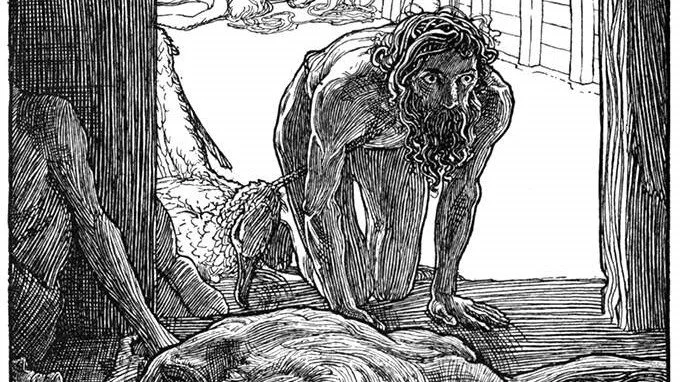Appalachian Folktales and Superstitions: Sin Eaters
Photo from: appalachiabare.com/sin-eater
Warm light flickers across the grief-stricken faces of silent mourners, most of whom avert their gazes from each other. The family huddles in the living room, tense, listening. The children grow more fearful, knowing the time draws near when he will come: the sin eater. The little girl has never seen the sin eater. Laying your eyes on the creature who is sustained by evil will curse you, after all. Her skin prickles, imagination running wild as the seconds trickle by.
Thump.
Thump.
Thump.
Creeeaaak.
He has arrived.
The family collectively holds their breath as they listen to the door creak open.
A whimper escapes the girl. Hey mother hushes her.
Their ears follow the sound of heavy footsteps as they travel to the room next to the one they hid.
This is where the body of her belated uncle was laid out, alongside a feast of various dishes, sides, and even desserts. The pies and cookies were especially tempting to the little girl. Her mother had to smack her hand away from the platter as they were preparing the ritual prior to nightfall.
The footsteps stop. A dish clanks. A moan.
The little girl’s imagination runs wild as she listens to the creature just on the other side of the wall. The shuffling, the grunting, a belch.
She wants to tiptoe to the doorway for just a little peak. But she doesn't dare to.
He must have been seven feet tall. He probably has a ghastly appearance. He only speaks in grunts. He must be a monster. How can you consume so much evil and not become evil, yourself?
She never realized the sin eater was only a man.
—————
Okay, so I’ll admit that I had fun writing this little anecdote. But I didn’t make it up.
This story came from my great-grandmother. She was born in Kentucky in 1916 to a family of Irish immigrants. This was a funeral practice from my family’s heritage: sin eating.
Photo from: eatsleepliveherefordshire.co.uk
Imagine the desperate, depraved monster that is fueled by sin.
Sin eating is a superstitious practice used historically throughout certain areas of Appalachia, with occurrences throughout Kentucky, West Virginia, and North Carolina. The belief is as follows: if a person passes away before they are able to confess or repent, their soul could be saved by a Sin Eater. The ritual traditionally included placing cookies, bread, a cup of beer near (or even on) the deceased. Symbolically, the food would absorb the sins from the dead, to then be consumed by the Sin Eater. Although the origin is debated, it is believed to have come to the Americas by way of Wales, Ireland, and Scotland.
In reality, the role of sin eater was sometimes performed by a close familial relation to the deceased, or by the town sin eater. In some instances, Sin Eating was sometimes a family trade passed down through generations. But more often, sin eaters were already outcasts from society and chose the position out of desperation.
Veiled in secrecy and stigma, the practice of sin-eating has drifted from whispered ritual into the realm of legend. The sin eaters themselves? Arguably, they martyred their own souls for the salvation of others. Yet rather than gratitude, they received suspicion. Rather than honor, exile. They were seen not as saviors, but as living vessels of sin.
In my great-grandmother’s case, the sin-eater was a hermit who lived miles from the village. To alert him that his craft was needed, they would light a lantern and place it outside their front door. They knew he would arrive during a certain time frame during the night, then leave after he finished his job (they would pay for his services by leaving coins out for him to collect). However, Grandma never learned how the sin-eater knew when to travel miles to town on foot to check for lanterns. He just knew. This played into her superstition with the practice.
According to Grandma Bessie: the bigger the sinner, the larger the feast. The average person only needed small portions of food, to cover the sin every person is believed to be born with. If a person was known to commit many sins, a full feast was necessary.
However, if the sin eater was unable to consume every last bite, it was all for naught and the sins wouldn’t be cleansed.
Side note: according to Grandma Bessie, our family had several people who needed quite a large meal to “get right.” She never clarified if all of their sins were successfully eaten or not.
Peewee Valley, KY circa 1940; Photo from: Bri’s personal collection
As one can imagine, over time as less people practiced sin-eating in real life and it faded from living memory, the few remaining stories were oftentimes exaggerated with the sin eater becoming a monster or spirit to be feared.
My journey into Appalachian folklore and superstition is clearly personal on my behalf. My ancestry traces back through this ancient range and the hollers, and the tale of the sin eater was passed to me through generations of women - most recently, my mother. In this and future blogs, I hope to explore not only the roots of these beliefs, but the enduring echoes they’ve left in our cultural memory.
It is difficult to find first hand accounts about the practice of sin eating in Appalachia, in part due to its taboo status, but also due to the fact that oral history is a much used practice there. I'm honored and incredibly lucky to have heard personal accounts of these topics and I plan to share much more in the future, if you dare to join me on this journey.
Written by Bri Barger
—————
Want more Appalachian stories? Check out Andronike’s blog, Moonshine & Myth:
spookysisterhood.com/blog/moonshine-amp-myth-appalachian-stories-that-will-make-you-shiver
Bonus Sin Eater content: appalachiabare.com/sin-eater/
—————
Sources:
traditionallegends.com/post/the-appalachian-sin-eaters-death-tradition-and-the-weight-of-a-soul
ivysbookclub.substack.com/p/what-is-a-sin-eater-an-opinion-piece?utm_campaign=post&utm_medium=web



